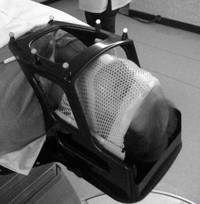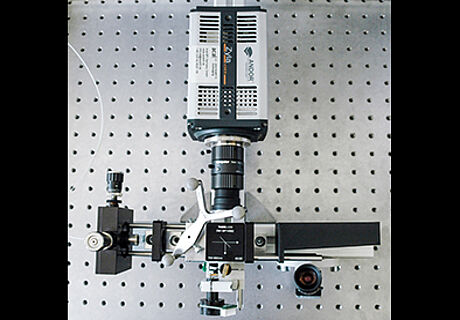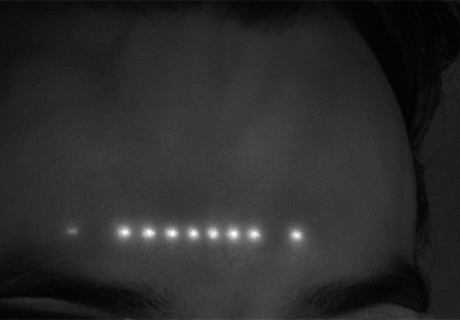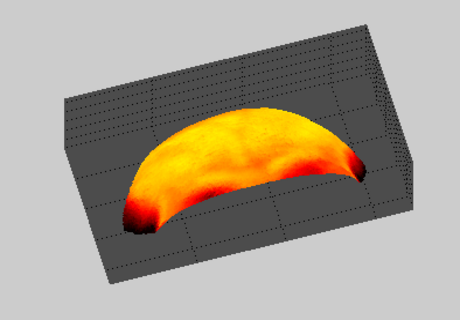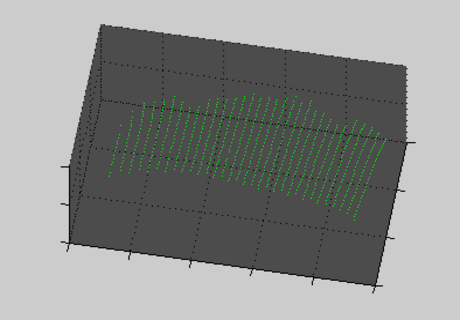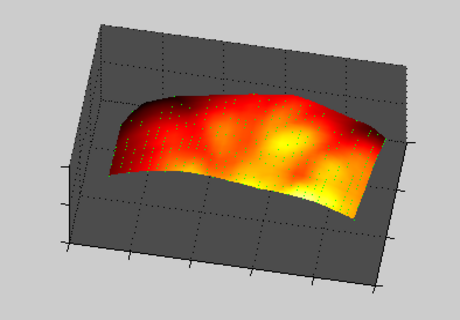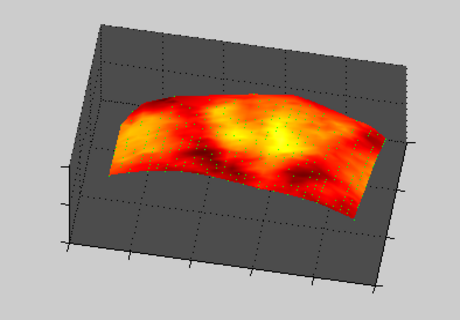High-Accuracy Head Tracking for Cranial Radiation Therapy
Project Description
Compensating for patient motion constitutes a challenging as well as important problem for high precision cranial radiotherapy. Common approaches rely on patient immobilization using stereotactic frames, masks or bite bars, or employ X-ray based monitoring and motion compensation such as the 6D skull tracking used by the CyberKnife®. These techniques entail several drawbacks: First, the mask systems are rather inconvenient and also not tolerated by all patients. They further provide no motion monitoring during the treatment - the patient is assumed to be fixed. This is indeed only true up to errors in millimeter range. Second, X-ray based imaging exposes the subject to an unnecessary amount of additional radiation. This exposure also limits the head-tracking speed to about 1 Hz.
Therefore, marker-less optical head-tracking provides a promising alternative, where a laser constantly scans the patient's forehead. This approach requires only light patient fixation and provides a basis for fast real-time monitoring. While promising results have already been achieved using commercial systems such as the Microsoft Kinect®, the accuracy still lags behind the desirable standard of sub-millimeter accuracy. One major drawback of marker-less tracking is given by the lack of point-to-point correspondences. Finding these, for objects which are not strictly rigid, is challenging and prone to registration errors. Point cloud matching algorithms are used which rely, if at all, on a few spatial landmarks. The surface geometry very often introduces further ambiguities which lead to a convergence into local error minima and hence poor robustness.
Figure (1) Laser scanning optics, (2) Laser scan of the forehead, (3) MRI segmented tissue ground truth.
By combining expertise from the fields of computer science, electronics, applied mathematics, machine learning and biomedical optics our research group works on laser triangulation, dedicated electronic and optical hardware, as well as enhanced tracking approaches. Specifically the feasibility of optically detecting subcutaneous as well as cutaneous structures is evaluated. The structures serve as supportive landmarks and can be used to localize rigid cranial bone. To uncover these landmarks the developed system extracts optical backscatter features. These are obtained from near-infrared (NIR) laser scans of the forehead. Finally, machine learning algorithms such as Gaussian Processes or Support Vector regression are used to obtain the tissue thickness. In cooperation with Varian Medical, Inc., the world-leading manufacturer for LINACs, we develop a novel prototype for high-accuracy head-tracking in radiotherapy.
Figure (1) Triangulated 3D surface point cloud, (2) feature-labeled point cloud, (3) reconstructed tissue-labeled point cloud.
Publications
2019
Human Forehead Recognition: A Novel Biometric Modality based on NIR Laser Backscattering Feature Image using Deep Transfer Learning, IET Biometrics , vol. online first, 2019. Institution of Engineering and Technology.
| DOI: | 10.1049/iet-bmt.2019.0015 |
| File: | iet-bmt.2019.0015 |
2018
Relationship between NIR laser power and the human forehead tissue backscattering image features: Photonic Solutions for Better Health Care VI, Popp, Jürgen and Tuchin, Valery V. and Pavone, Francesco S., Eds. Strasbourg (France): SPIE, 2018. pp. 136.
| DOI: | 10.1117/12.2306827 |
| ISBN: | 9781510618961 |
| File: | 12.2306827 |
Patient identification using a near-infrared laser scanner: Image-Guided Procedures, Robotic Interventions, and Modeling, Orlando, FL: SPIE, 2017. pp. 101352L.
| DOI: | 10.1117/12.2254963 |
| File: | 12.2254963 |
2016
Enhanced Optical Head Tracking for Cranial Radiotherapy: Supporting Surface Registration by Cutaneous Structures, International Journal of Radiation Oncology, Biology, Physics , vol. 95, no. 2, pp. 810-817, 2016.
| DOI: | 10.1016/j.ijrobp.2016.01.041 |
| File: | j.ijrobp.2016.01.041 |
2015
Enhanced Tissue Thickness Computation by Exploiting Local Neighborhoods, Barcelona, Spain , 2015.
Tissue Segmentation from Head MRI: A Ground Truth Validation for Feature-Enhanced Tracking, Lübeck, Germany , 2015. pp. S184.
| DOI: | 10.1515/bmt-2015-5008 |
| File: | bmt-2015-5008 |
Ray Interpolation for Generic Triangulation Based on a Galvanometric Laser Scanning System, New York: IEEE, 2015. pp. 1419-1422.
| DOI: | 10.1109/ISBI.2015.7164142 |
| File: | ISBI.2015.7164142 |
Optical localization of the human skull for cranial radiation therapy, Atlanta, GA, USA , 2015.
Enriching 3D optical surface scans with prior knowledge: tissue thickness computation by exploiting local neighborhoods, International Journal of Computer Assisted Radiology and Surgery , vol. 11, no. 4, pp. 569-579, 2015. Springer Berlin Heidelberg.
| DOI: | 10.1007/s11548-015-1246-6 |
| File: | s11548-015-1246-6 |
Data-driven Learning for Calibrating Galvanometric Laser Scanners, IEEE Sensors Journal , vol. 15, no. 10, pp. 5709-5717, 2015.
| DOI: | 10.1109/jsen.2015.2447835 |
| File: | jsen.2015.2447835 |
Efficient Estimation of Tissue Thicknesses using Sparse Approximation for Gaussian Processes, Milano, Italy: IEEE, 2015. pp. 7015-7018.
| DOI: | 10.1109/EMBC.2015.7320007 |
| File: | EMBC.2015.7320007 |
Calibration of galvanometric laser scanners using statistical learning methods, Berlin, Heidelberg, New York; Lübeck, Germany: Springer, 2015. pp. 467-472.
| DOI: | 10.1007/978-3-662-46224-9_80 |
| File: | 978-3-662-46224-9_80 |
Analysis of feature stability for laser-based determination of tissue thickness, San Francisco, CA , 2015. pp. 93130Q.
| DOI: | 10.1117/12.2078722 |
| File: | 12.2078722 |
An Approach to Improve Accuracy of Optical Tracking Systems in Cranial Radiation Therapy, Cureus , vol. 7, no. 1, pp. e239, 2015.
A Study of Gaussian Noise Effects on Skin Thickness Measurement, Lübeck, Germany , 2015. pp. S190.
| DOI: | 10.1515/bmt-2015-5008 |
| File: | bmt-2015-5008 |
2014
Measuring cranial soft tissue thickness with MRI or pressure-compensated tracked ultrasound, British Journal of Medicine and Medical Research , vol. 4, no. 4, pp. 937-948, 2014.
Tissue Thickness Estimation for High Precision Head-Tracking using a Galvanometric Laser Scanner - A Case Study, Chicago, IL: IEEE, 2014. pp. 3106-3109.
A comparison of different hardware design approaches for feature-supported optical tracking with respect to angular dependencies, 2014. pp. 204.
| DOI: | 10.1118/1.4888259 |
| File: | 1.4888259 |
Kalman Filter based Head Tracking for Cranial Radiation Therapy with low-cost Range-Imaging Cameras, Deserno, Thomas M. and Handels, Heinz and Tolxdorff, Thomas and Meinzer, Hans-Peter and Ehrhardt, Jan, Eds. Aachen, Germany; Berlin, Heidelberg: Springer, 2014. pp. 324-329.
| DOI: | 10.1007/978-3-642-54111-7_60 |
| File: | 978-3-642-54111-7_60 |
Accuracy analysis for triangulation and tracking based on time-multiplexed structured light, Medical Physics , vol. 41, no. 8, pp. 082701, 2014.
| DOI: | 10.1118/1.4890093 |
| File: | 1.4890093 |
2013
Accuracy of object tracking based on time-multiplexed structured light, Innsbruck, Austria , 2013. pp. 139-142.
An improvement for the scanning process in high accuracy head tracking, Innsbruck, Austria , 2013. pp. 179-182.
Design and evaluation of a highly accurate optical setup for backscatter analysis, Treuer, Harald, Eds. Cologne, Germany , 2013. pp. 181-186.
Veröffentlichungen
2019
Human Forehead Recognition: A Novel Biometric Modality based on NIR Laser Backscattering Feature Image using Deep Transfer Learning, IET Biometrics , vol. online first, 2019. Institution of Engineering and Technology.
| DOI: | 10.1049/iet-bmt.2019.0015 |
| File: | iet-bmt.2019.0015 |
2018
Relationship between NIR laser power and the human forehead tissue backscattering image features: Photonic Solutions for Better Health Care VI, Popp, Jürgen and Tuchin, Valery V. and Pavone, Francesco S., Eds. Strasbourg (France): SPIE, 2018. pp. 136.
| DOI: | 10.1117/12.2306827 |
| ISBN: | 9781510618961 |
| File: | 12.2306827 |
Patient identification using a near-infrared laser scanner: Image-Guided Procedures, Robotic Interventions, and Modeling, Orlando, FL: SPIE, 2017. pp. 101352L.
| DOI: | 10.1117/12.2254963 |
| File: | 12.2254963 |
2016
Enhanced Optical Head Tracking for Cranial Radiotherapy: Supporting Surface Registration by Cutaneous Structures, International Journal of Radiation Oncology, Biology, Physics , vol. 95, no. 2, pp. 810-817, 2016.
| DOI: | 10.1016/j.ijrobp.2016.01.041 |
| File: | j.ijrobp.2016.01.041 |
2015
Enhanced Tissue Thickness Computation by Exploiting Local Neighborhoods, Barcelona, Spain , 2015.
Tissue Segmentation from Head MRI: A Ground Truth Validation for Feature-Enhanced Tracking, Lübeck, Germany , 2015. pp. S184.
| DOI: | 10.1515/bmt-2015-5008 |
| File: | bmt-2015-5008 |
Ray Interpolation for Generic Triangulation Based on a Galvanometric Laser Scanning System, New York: IEEE, 2015. pp. 1419-1422.
| DOI: | 10.1109/ISBI.2015.7164142 |
| File: | ISBI.2015.7164142 |
Optical localization of the human skull for cranial radiation therapy, Atlanta, GA, USA , 2015.
Enriching 3D optical surface scans with prior knowledge: tissue thickness computation by exploiting local neighborhoods, International Journal of Computer Assisted Radiology and Surgery , vol. 11, no. 4, pp. 569-579, 2015. Springer Berlin Heidelberg.
| DOI: | 10.1007/s11548-015-1246-6 |
| File: | s11548-015-1246-6 |
Data-driven Learning for Calibrating Galvanometric Laser Scanners, IEEE Sensors Journal , vol. 15, no. 10, pp. 5709-5717, 2015.
| DOI: | 10.1109/jsen.2015.2447835 |
| File: | jsen.2015.2447835 |
Efficient Estimation of Tissue Thicknesses using Sparse Approximation for Gaussian Processes, Milano, Italy: IEEE, 2015. pp. 7015-7018.
| DOI: | 10.1109/EMBC.2015.7320007 |
| File: | EMBC.2015.7320007 |
Calibration of galvanometric laser scanners using statistical learning methods, Berlin, Heidelberg, New York; Lübeck, Germany: Springer, 2015. pp. 467-472.
| DOI: | 10.1007/978-3-662-46224-9_80 |
| File: | 978-3-662-46224-9_80 |
Analysis of feature stability for laser-based determination of tissue thickness, San Francisco, CA , 2015. pp. 93130Q.
| DOI: | 10.1117/12.2078722 |
| File: | 12.2078722 |
An Approach to Improve Accuracy of Optical Tracking Systems in Cranial Radiation Therapy, Cureus , vol. 7, no. 1, pp. e239, 2015.
A Study of Gaussian Noise Effects on Skin Thickness Measurement, Lübeck, Germany , 2015. pp. S190.
| DOI: | 10.1515/bmt-2015-5008 |
| File: | bmt-2015-5008 |
2014
Measuring cranial soft tissue thickness with MRI or pressure-compensated tracked ultrasound, British Journal of Medicine and Medical Research , vol. 4, no. 4, pp. 937-948, 2014.
Tissue Thickness Estimation for High Precision Head-Tracking using a Galvanometric Laser Scanner - A Case Study, Chicago, IL: IEEE, 2014. pp. 3106-3109.
A comparison of different hardware design approaches for feature-supported optical tracking with respect to angular dependencies, 2014. pp. 204.
| DOI: | 10.1118/1.4888259 |
| File: | 1.4888259 |
Kalman Filter based Head Tracking for Cranial Radiation Therapy with low-cost Range-Imaging Cameras, Deserno, Thomas M. and Handels, Heinz and Tolxdorff, Thomas and Meinzer, Hans-Peter and Ehrhardt, Jan, Eds. Aachen, Germany; Berlin, Heidelberg: Springer, 2014. pp. 324-329.
| DOI: | 10.1007/978-3-642-54111-7_60 |
| File: | 978-3-642-54111-7_60 |
Accuracy analysis for triangulation and tracking based on time-multiplexed structured light, Medical Physics , vol. 41, no. 8, pp. 082701, 2014.
| DOI: | 10.1118/1.4890093 |
| File: | 1.4890093 |
2013
Accuracy of object tracking based on time-multiplexed structured light, Innsbruck, Austria , 2013. pp. 139-142.
An improvement for the scanning process in high accuracy head tracking, Innsbruck, Austria , 2013. pp. 179-182.
Design and evaluation of a highly accurate optical setup for backscatter analysis, Treuer, Harald, Eds. Cologne, Germany , 2013. pp. 181-186.

- Research
- Robotics Laboratory (RobLab)
- OLRIM
- MIRANA
- Robotik auf der digitalen Weide
- KRIBL
- Ultrasound Guided Radiation Therapy
- Digitaler Superzwilling: Projekt TWIN-WIN
- - Finished Projects -
- High-Accuracy Head Tracking
- Neurological Modelling
- Modelling of Cardiac Motion
- Motion Compensation in Radiotherapy
- Navigation and Visualisation in Endovascular Aortic Repair (Nav EVAR)
- Autonome Elektrofahrzeuge als urbane Lieferanten
- Goal-based Open ended Autonomous Learning
- Transcranial Electrical Stimulation
- Treatment Planning
- Transcranial Magnetic Stimulation
- Navigation in Liver Surgery
- Stereotactic Micronavigation
- Surgical Microscope
- Interactive C-Arm
- OCT-based Neuro-Imaging
Floris Ernst

Gebäude 64
,
Raum 97
floris.ernst(at)uni-luebeck.de
+49 451 31015208

